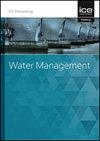几个版本的排水面积比法转移每日或每月的溪流流量
IF 0.9
4区 工程技术
Q3 ENGINEERING, CIVIL
Proceedings of the Institution of Civil Engineers-Water Management
Pub Date : 2023-02-02
DOI:10.1680/jwama.21.00091
引用次数: 1
摘要
排水面积比法是将附近站点测量到的日或月流量与大坝断面与站点的排水面积之比提高到指数(n)的实数相乘,将其转移到待建大坝的未测量断面,通常取n为1。首先,利用坝段附近两个站点在同一条河流或相邻河流上的日流量,具有共同的N年长测量记录,提出对365对日流量拟合365个线性回归,并将其与流域面积比联系起来,用365个属于一天的N来计算坝段日流量。其次,采用与月流量相同的分析模型,将12个月的流量转移到坝段。研究了五种不同版本的排水面积比法,其中三种是常指数法,最后一种n = 1的排水面积比法相对最差。本文章由计算机程序翻译,如有差异,请以英文原文为准。
A few versions of the drainage-area ratio method for transfer of daily or monthly stream flows
By the drainage-area ratio method, the daily or monthly flows gauged at a nearby station are transferred to an ungauged section where a dam is to be built by multiplying them by the real number resulting from raising the ratio of the drainage areas of the dam section and of the station to an exponent (n). Commonly n is taken as 1. First, using the daily flows of two stations nearby the dam section on the same stream or on a neighboring stream, having a common N-year long gauging record, it is proposed that 365 linear regressions be fitted to N pairs of 365 daily flows, and relating them to the drainage area ratios, daily flows at the dam section be computed using 365 n's each belonging to a day. Next, by the same analytical model applied to the monthly flows, 12 monthly flows are transferred to the dam section. Five versions of the drainage-area ratio method, three of which with constant exponents, are investigated, and the last one with n = 1 is found to be relatively the worst.
求助全文
通过发布文献求助,成功后即可免费获取论文全文。
去求助
来源期刊
CiteScore
2.10
自引率
0.00%
发文量
28
审稿时长
6-12 weeks
期刊介绍:
Water Management publishes papers on all aspects of water treatment, water supply, river, wetland and catchment management, inland waterways and urban regeneration.
Topics covered: applied fluid dynamics and water (including supply, treatment and sewerage) and river engineering; together with the increasingly important fields of wetland and catchment management, groundwater and contaminated land, waterfront development and urban regeneration. The scope also covers hydroinformatics tools, risk and uncertainty methods, as well as environmental, social and economic issues relating to sustainable development.

 求助内容:
求助内容: 应助结果提醒方式:
应助结果提醒方式:


